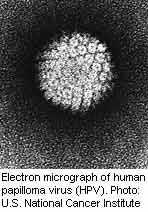
THURSDAY, Jan. 6 (HealthDay News) — Among HIV-negative sexual partners, male circumcision helps prevent the transmission of human papillomavirus from men to women, according to a new study.
However, circumcision offers only partial protection and partners must still practice safe sex, the researchers pointed out.
Human papillomavirus (HPV) is a sexually transmitted infection that puts women at risk for cervical cancer. Previous research has shown that circumcision reduces the risk of HPV infection in men.
In this new study, researchers analyzed data from two clinical trials in Uganda that followed HIV-negative men and their HIV-negative female partners between 2003 and 2006. The incidence of new high-risk HPV infection was 23 percent lower for women with circumcised partners than for those with uncircumcised partners, the investigators found.
“Along with previous trial results in men, these findings indicate that male circumcision should now be accepted as an efficacious intervention for reducing heterosexually acquired high-risk and low-risk HPV infections in men who do not have HIV and in their female partners. However, our results indicate that protection is only partial; the promotion of safe sex practices is also important,” concluded Drs. Aaron Tobian and Maria Wawer, of Johns Hopkins University in Baltimore.
The study was published online Jan. 6 in The Lancet.
In an accompanying commentary, Dr. Anna R. Giuliano of the H. Lee Moffitt Cancer Center in Tampa, Fla., and colleagues wrote: “Recent findings add important evidence for the promotion of male circumcision in countries without well-established programs for cervical screening. Additional interventions to reduce HPV infection, such as provision of vaccines for HPV prevention, will be essential to reduce invasive cervical cancer worldwide. Male circumcision is associated with slight reductions in high-risk HPV, while licensed HPV vaccines protect with high effectiveness against only a limited number of HPV types. Therefore, the two interventions are likely to have important synergistic effects.”
More information
The U.S. Centers for Disease Control and Prevention has more about HPV prevention.

